Dynamometer or Electrodynamic Type Wattmeter
The two main types of wattmeters are The dynamometer or electrodynamic type wattmeter and the induction type wattmeter.
Dynamometer or Electrodynamic Type Wattmeter
The basic principle of dynamometer instrument has already been explained in detail in Article Electrodynamic or Dynamometer Type Instruments. The connections of a dynamometer type wattmeter are shown in Figure A.

The fixed circular coil which carries the main circuit current I1 is wound in two halves positioned parallel to each other. The distance between the two halves can be adjusted to give a uniform magnetic field. The moving coil which is pivoted centrally carries a current I2 which is proportional to the voltage V. Current I2 is led into the moving coil by two springs which also supply the necessary controlling torque. The equivalent diagrammatic view is shown in Figure B.
AdBlock-2
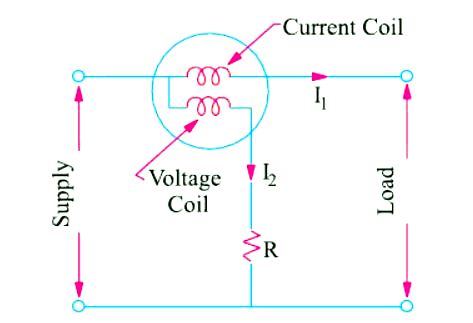
Deflecting Torque
Since coils are air-cored, the flux density produced is directly proportional to the current I1.
∴ B ∝ I1 or B = K1I1 ; current I2 ∝ V or I2 = K2V
Now Td ∝ BI2 ∝ I1V
∴ Td = KV I1 = K × power
In D.C. circuits, power is given by the product of voltage and current in amperes, hence torque is directly proportional to the power.
Let us see how this instrument indicates true power on A.C. circuits.
For A.C. supply, the value of instantaneous torque is given by Tinst ∝ vi = K vi
where v = instantaneous value of voltage across the moving coil
i = instantaneous value of current through the fixed coils.
However, owing to the large inertia of the moving system, the instrument indicates the mean or average power.
∴ Mean deflecting torque Tm ∝ average value of υi

where V and I are the r.m.s. values.
∴ Tm ∝ VI cos φ ∝ true power.
Hence, we find that in the case of A.C. supply also, the deflection is proportional to the true power in the circuit.
Scales of dynamometer wattmeters are more or less uniform because the deflection is proportional to the average power and for spring control, controlling torque is proportional to the deflection. Hence θ ∝ power. Damping is pneumatic with the help of a piston moving in an air chamber as shown in Figure C.
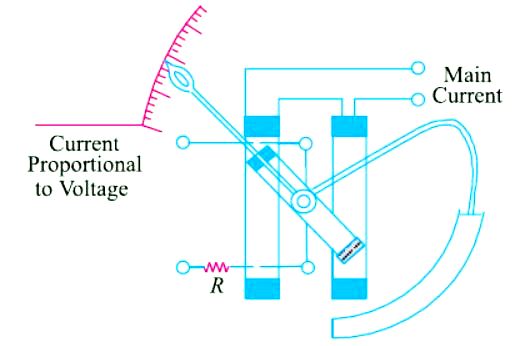
Errors in Dynamometer or Electrodynamic Type Wattmeter
The inductance of the moving or voltage coil is liable to cause error but the high non-inductive resistance connected in series with the coil swamps, to a great extent, the phasing effect of the voltage-coil inductance. Another possible error in the indicated power may be due to
(i) Some voltage drop in the circuit or
(ii) The current taken by the voltage coil.
In standard wattmeters, this defect is overcome by having an additional compensating winding which is connected in series with the voltage coil but is so placed that is produces a field in opposite direction to that of the fixed or current coils.
(i) Error Due to Different Connections
Two possible ways of connecting a wattmeter in a single-phase a.c. circuit are shown in Figure D along with their phasor diagrams. In Figure D, the pressure or voltage-coil current does not pass through the current coil of the wattmeter whereas in the connection of Figure E is passes. A wattmeter is supposed to indicate the power consumed by the load but its actual reading is slightly higher due to power losses in the instrument circuits. The amount of error introduced depends on the connection.
(a) Consider the connection of Figure D. If cos φ is the power factor of the load, then power in the load is VI cos θ. Now, voltage across the pressure-coil of the wattmeter is V1 which is the phasor sum of the load voltage V and potential difference across current-coil of the instrument i.e. V′ (= Ir where r is the resistance of the current coil).
Hence, power reading as indicated by the wattmeter is = V1Icos θ
where θ = phase difference between V1 and I as shown in the phasor diagram of Figure D.
As seen from the phasor diagram, V1cos θ = (Vcos φ + V′ )
∴ wattmeter reading = V1cos θ . I = (Vcos φ + V′)I
= VIcos φ + V′I = VIcos φ + I2r = power in load + power in current coil.
(b) Next, consider the connection of Figure E. The current through the current-coil of the wattmeter is the phasor sum of load current I and voltage-coil current I′ = V/R. The power reading indicated by the wattmeter is = VI1 cos θ.
As seen from the phasor diagram of Figure E, I1cos θ = (I cos φ + I′ )
∴ wattmeter reading = V (Icos φ + I′ ) = VI cos φ + VI′ = VI cos φ + V2/R
= power in load + power in pressure-coil circuit
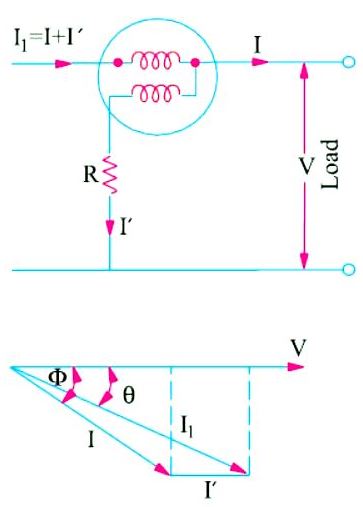
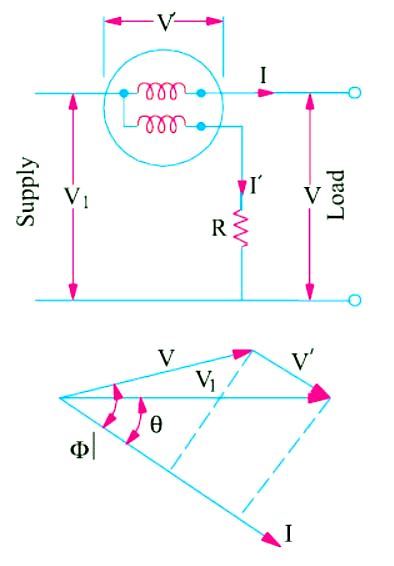
(ii) Error Due to Voltage-coil Inductance
While developing the theory of electrodynamic instruments, it was assumed that pressure-coil does not posses any inductance (and hence reactance) so that current drawn by it was = V/R. The wattmeter reading is proportional to the mean deflecting torque, which is itself proportional to I1I2 cos θ, where θ is the angle between two currents (Figure F).
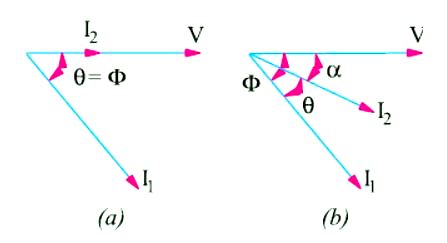
(iii) Error Due to Capacitance in Voltage-coil Circuit
There is always present a small amount of capacitance in the voltage-coil circuit, particularly in the series resistor. Its effect is to reduce angle α and thus reduce error due to the inductance of the voltage coil circuit. In fact, in some watt-meters, a small capacitor is purposely connected in parallel with the series resistor for obtaining practically non-inductive voltage-coil circuit. Obviously, over compensation will make resultant reactance capacitive thus making α negative in the above expressions.
(iv) Error Due to Stray Fields
Since operating field of such an instrument is small, it is very liable to stray field errors. Hence, it should be kept as far away as possible from stray fields. However, errors due to stray fields are, in general, negligible in a properly-constructed instrument.
(v) Error Due to Eddy Currents
The eddy current produced in the solid metallic parts of the instrument by the alternating field of the current coil changes the magnitude and strength of this operating field thus producing an error in the reading of the wattmeter. This error is not easily calculable although it can be serious if care is not taken to remove away solid masses of metal from the proximity of the current coil.

Advantages and Disadvantages
By careful design, such instruments can be built to give a very high degree of accuracy. Hence they are used as a standard for calibration purposes. They are equally accurate on D.C. as well as A.C. circuits.
However, at low power factors, the inductance of the voltage coil causes serious error unless special precautions are taken to reduce this effect.
Read article – electrodynamic instruments
Visit NCERTplanet.com for NCERT solutions and Textbook downloads




